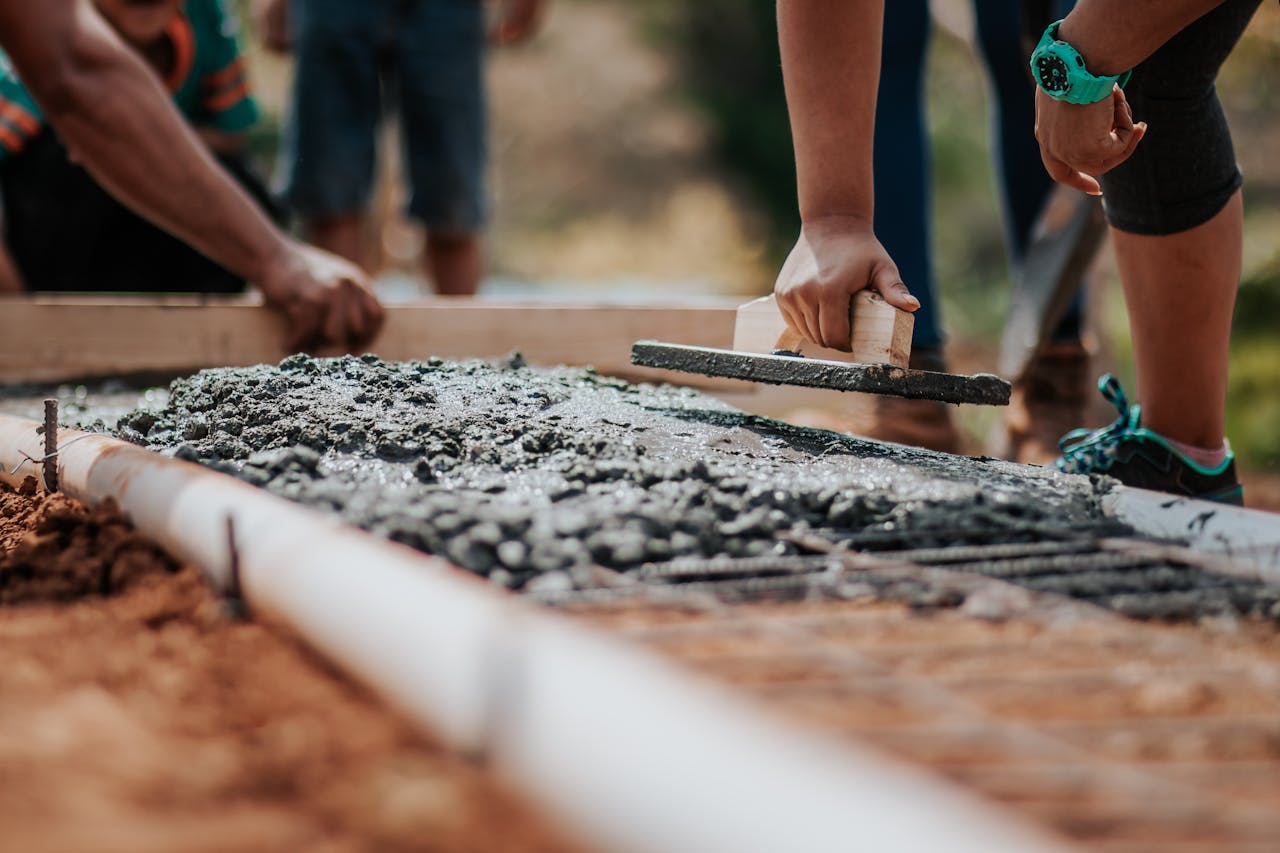- ALFRAN - OUR HOUSE BRAND
- Pipes
- Fittings
- Valves
- SOLAR PV SYSTEM
- Accessories
- Building Materials
- KITCHEN SERIES
- BATHROOM SERIES
- OTHERS - NON BUILDING MATERIALS
Safety First: A Complete Guide to Construction Safety Net (2024)
May, 30 2024
Author: Unitrade
Share This With

Construction safety nets are a vital part of any construction project. Not only does it ensure the well-being of workers, but it also prevents undue harm from being inflicted on nearby civilians and property in the event of accidents. With an abundance of types and sizes of nets to choose from, all made from extremely strong and dense mesh, there is no excuse not to have a safety net in your project today.
What are Construction Safety Nets
A construction safety net is a protective measure used in construction sites to prevent or minimise injuries to workers or bystanders in the event of falls from heights or falling objects. These nets are typically made of high-strength synthetic materials like nylon or polypropylene. The nets are also designed to absorb the energy of a falling person or object, thereby reducing the impact force and preventing serious injury or fatalities.
Construction safety nets are often installed horizontally beneath elevated work areas such as scaffolding, bridges, or roof edges. They can also be used vertically to enclose open elevator shafts or stairwells. These nets are designed to catch anyone or anything that falls, providing a cushioning effect and preventing falls to lower levels.
In addition to safety nets, construction sites may also utilise other fall protection measures such as guardrails, personal fall arrest systems (like harnesses and lanyards), toe boards, and safety barriers to create a safe working environment at height.
Type of Construction Safety Net
Construction safety nets come in several types, each serving specific purposes and offering varying levels of protection. Here are the most common types of construction safety nets:
1. Fall Arrest Nets
Fall arrest nets are designed to catch falling workers or objects and absorb the impact energy to prevent injury or damage. They are typically installed horizontally beneath elevated work areas such as scaffolding, bridges, or roofs. Fall arrest nets are constructed of high-strength synthetic materials like nylon or polypropylene and can support significant loads.
2. Debris Nets
Debris nets, also known as scaffold or construction debris netting, are primarily used to contain falling debris or materials during construction activities. They help prevent objects from falling off scaffolding or elevated work areas, reducing the risk of injury to workers below and minimising damage to property or equipment. Debris nets are usually installed vertically along the perimeter of a construction site or around scaffolding structures.
3. Personnel Safety Nets
Personnel safety nets are similar to fall arrest nets but are specifically designed to protect workers from falls while working at height. They are commonly used in construction projects where workers are exposed to elevated work surfaces or open edges. Personnel safety nets are installed horizontally to safely catch and cushion falling workers, preventing or minimising injuries.
4. Vertical Safety Nets
Vertical safety nets are installed vertically to enclose open elevator shafts, stairwells, or other vertical openings on construction sites. They provide a barrier to prevent falls and protect workers from accidentally stepping into these openings. Vertical safety nets are often used with other fall protection measures, such as guardrails or toe boards, to create a safe working environment.
5. Perimeter Safety Nets:
Perimeter safety nets are installed along the perimeter of a construction site to prevent objects or debris from falling outside the work area. They help protect pedestrians, neighbouring properties, and vehicles from potential hazards associated with construction activities. Perimeter safety nets may be installed at various heights depending on the specific requirements of the construction project.
These types of construction safety nets play a crucial role in ensuring the safety of workers, bystanders, and the surrounding environment on construction sites. They are typically installed according to safety regulations and industry standards to provide effective fall protection and hazard mitigation.
Construction Safety Net Sizes
Construction safety nets come in various sizes to accommodate different types of construction projects and coverage requirements. The sizes of safety nets can vary depending on factors such as the intended use, the work area size, and specific regulations or standards needed. Here are some common sizes of construction safety nets:
- Standard Widths: Construction safety nets commonly range from 5 feet (1.5 metres) to 30 feet (9 metres) or more, fitting standard scaffolding configurations and elevated surfaces.
- Custom Lengths: Tailored to specific needs, safety nets can be custom-cut to ensure precise coverage, minimising gaps and optimising fall protection.
- Panel Sizes: Safety nets may come in individual panels or sections, allowing for flexibility in covering diverse areas and accommodating varying construction layouts.
- Vertical Heights:** Vertical safety nets are adjustable to match the height of openings or structures, ranging from several feet to tens of feet, ensuring comprehensive perimeter protection.
- Custom Configurations: Construction safety nets can be customised to address unique project requirements, including irregular workspaces or specialised safety regulations. Width, length, height, or mesh density adjustments ensure optimal performance and compliance with safety standards.
It’s essential to consult with safety professionals, manufacturers, or suppliers to determine the appropriate size and configuration of safety nets based on the specific needs and conditions of the construction project. Proper sizing and installation are critical to ensuring effective fall protection and hazard mitigation on construction sites.
Strength Tolerance of Construction Safety Nets
The strength tolerance of a construction safety net refers to the maximum load or force that the net can withstand without failing or exceeding its design limits. The strength tolerance is typically expressed in weight or force capacity per unit area, such as pounds per square foot (PSF) or kilonewtons per square metre (kN/m²).
The strength tolerance of construction safety nets can vary depending on several factors, including:
- Material Composition: Safety nets are typically crafted from high-strength synthetic materials like nylon or polypropylene. Material choice and manufacturing processes significantly impact net strength and durability.
- Mesh Size and Density: The mesh size and density directly affect a safety net’s ability to absorb and distribute impact forces. Nets with smaller mesh sizes and higher densities usually exhibit greater strength tolerance.
- Construction Standards: Safety nets are subject to industry standards and regulations governing strength, performance, and safety. These standards, varying by region or jurisdiction, often mandate minimum strength tolerances and rigorous testing procedures.
- Load Ratings: Safety nets undergo laboratory testing and certification to determine specific load capacities. Factors such as static and dynamic loads, impact forces, and environmental conditions influence these ratings.
- Installation and Maintenance: Proper installation and regular maintenance are vital for maintaining safety net strength and performance. Nets must be securely anchored, correctly tensioned, and routinely inspected for wear or damage to ensure continued effectiveness in fall protection.
While the strength tolerance of construction safety nets can vary, they are designed to withstand significant loads and provide reliable fall protection for workers and bystanders on construction sites. It’s essential to select safety nets with adequate strength tolerance for the specific application and to comply with relevant safety standards and regulations.
Benefits of Using a Construction Safety Net
Using a construction safety net offers several benefits for both workers and construction projects:
- Fall Prevention: Safety nets serve as a proactive measure to prevent falls from elevated work areas, reducing the risk of accidents and injuries among workers.
- Fall Protection: In the event of a fall, safety nets act as a reliable cushioning system, absorbing the impact energy and reducing the severity of injuries or fatalities.
- Reduced Risk of Property Damage: Safety nets help contain falling debris or objects, minimising the potential for property damage and liabilities associated with construction activities.
- Compliance with Regulations: Using safety nets ensures compliance with safety regulations and standards set by government agencies and industry organisations, reducing the risk of fines or legal issues.
- Cost Savings: While initial investment in safety nets is required, their use can result in long-term cost savings by reducing the likelihood of workplace accidents, injuries, and associated expenses such as medical bills, worker compensation claims, and project delays.
- Enhanced Reputation: Employing safety nets demonstrates a commitment to worker safety and project quality, boosting the reputation of construction companies among clients, stakeholders, and regulatory bodies.
- Improved Worker Morale: Providing safety measures like nets fosters a positive work environment, boosting worker morale and retention rates.
- Versatility: Safety nets are versatile and can be adapted to various construction scenarios, including different types of scaffolding, bridges, roofs, and vertical openings.
Overall, construction safety nets contribute to a safer and more efficient construction process, protecting workers, bystanders, and property while complying with regulations and minimising risks and liabilities.
How to Install a Construction Safety Net
Installing a construction safety net involves several steps to ensure proper setup and effectiveness. Here’s a general guideline for installing a safety net:
1. Assess the Work Area
Before installation, carefully assess the work area to determine the appropriate placement and configuration of the safety net. Consider factors such as the height of the work surface, potential fall hazards, and the required coverage area.
2. Select the Type of Safety Net
Choose the appropriate type of safety net based on the specific needs of the construction project, such as fall arrest nets, debris nets, personnel safety nets, or vertical safety nets.
3. Prepare Anchorage Points
Install suitable anchorage points or attachment devices capable of supporting the weight and force exerted on the safety net. Ensure anchorage points are securely fixed to structural elements capable of withstanding the loads applied during a fall.
4. Install Netting Supports
Erect support structures, such as perimeter posts or scaffold frames, to provide the necessary framework for suspending the safety net. Ensure that supports are stable, properly braced, and capable of securely holding the netting.
5. Unfold the Safety Net
Carefully unfurl the safety net over the designated area, ensuring that it covers the entire work surface and extends beyond the edges to provide adequate coverage and overlap.
6. Secure the Net
Attach the edges of the safety net to the support structures using appropriate fasteners, such as hooks, clips, or ties. Ensure the net is taut and securely attached to prevent sagging or movement.
7. Inspect the Installation
Conduct a thorough inspection of the safety net installation to verify that all components are properly secured and aligned. Check for any signs of damage or wear that may compromise the effectiveness of the net.
8. Test the Installation
Perform a test deployment of the safety net by applying a controlled load or weight to simulate a fall scenario. Verify that the net functions as intended, effectively arresting the fall and distributing the impact energy.
9. Provide Training
Train workers on the proper use and limitations of the safety net, including procedures for accessing and working near the netted area, as well as protocols for inspecting and maintaining the netting system.
10. Regular Maintenance
Schedule regular inspections and maintenance of the safety netting system to ensure continued effectiveness and compliance with safety standards. Address any issues or concerns promptly to maintain a safe working environment.
With these steps and adhering to safety guidelines and regulations, construction safety nets can be installed effectively to provide reliable fall protection and hazard mitigation on construction sites.
Construction Safety Net Supplier Malaysia
Safety is an immense priority for any contractor in the industry, not only because people’s lives are at stake, but a company’s face, productivity, and revenue are all on the line. Being one of the most effective and accessible ways of protection for construction sites in the market, there is no reason why you shouldn’t invest in a construction safety net today.
To understand what type of construction safety net you need, and gain information on how much you will need and how to install it properly, consultation with professionals in the field is a must. This is where Unitrade, a local leading supplier of construction materials, comes into play. To get your hands on the most premium construction safety netting in the market, visit the official Unitrade website today.
FAQ:
Can construction safety nets be customised for specific project needs?
Yes, safety nets can be customised in size, configuration, and material to meet unique project requirements, such as irregular workspaces or specialised safety regulations. Customisation ensures optimal performance and compliance with safety standards.
How do construction safety nets compare to other fall protection systems?
Construction safety nets offer advantages over other fall protection systems such as guardrails or personal fall arrest systems. They provide collective protection, meaning they protect multiple workers simultaneously, and they can be more cost-effective for certain types of construction work.
Can construction safety nets be reused after a fall incident?
Usually, safety nets can be reused after a fall incident if they pass inspection and are deemed structurally sound. However, nets should be thoroughly inspected before being used again to ensure they meet safety standards and requirements.
Do construction safety nets have a lifespan?
Yes, safety nets have a lifespan determined by factors such as material degradation, exposure to environmental conditions, and wear and tear from use. Manufacturers often provide guidelines for the expected lifespan of their nets, and regular inspections help determine when nets need to be replaced.
Are there specific requirements for storing and maintaining construction safety nets when not in use?
Yes, safety nets should be stored in a clean, dry area away from sources of heat or sunlight when not in use. They should be inspected regularly for signs of damage or degradation, and any issues should be addressed promptly to ensure continued effectiveness.
-
Category
Uncategorized -
Tags
Safety First: A Complete Guide to Construction Safety Net (2024)
Read moreA Complete Guide to the Advantages of HDPE Pipes in Modern Infrastructure (2024)
Read morePortland Composite Cement (PCC) – An Overview (+ FREE Quotation)
Read morenewsletter Subscription
Sign Up Now & Stay Tune With Our Latest News & Product Updates!


